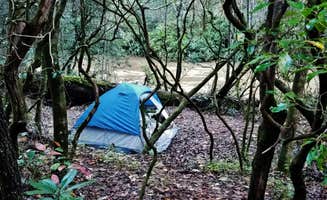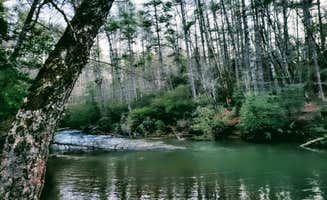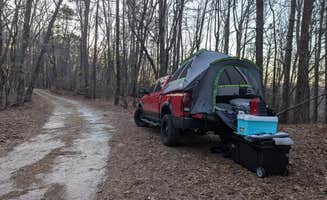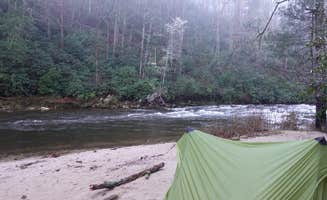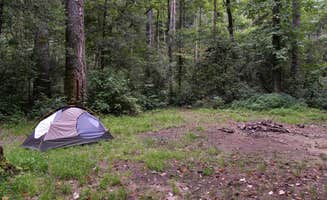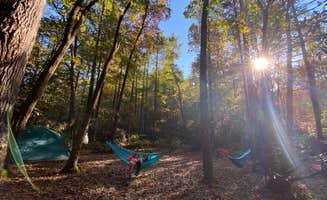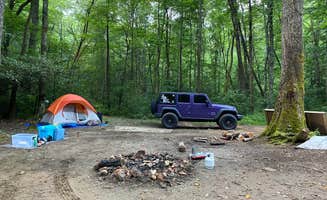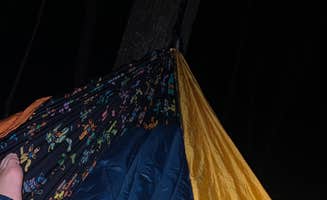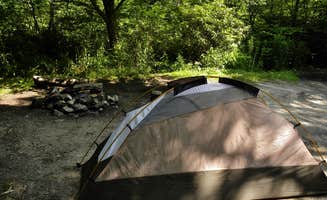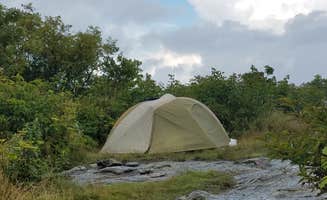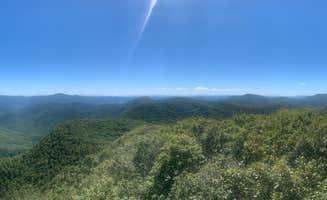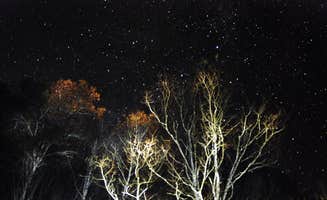Dispersed camping near Clemson, South Carolina offers multiple free backcountry options throughout the Sumter National Forest region, with most sites concentrated within a 30-45 minute drive of the university town. These primitive camping areas generally sit at elevations between 800-1,500 feet, creating moderate temperature variations between day and night, particularly during spring and fall seasons. Weather patterns in this transitional zone between piedmont and mountains can change quickly, with afternoon thunderstorms common in summer months.
What to do
Waterfall hiking: Multiple dispersed camping areas provide access to waterfall trails. At Glen Falls Backcountry Campground, campers can take "a nicer side for a backcountry campground as it is level and has multiple areas for tents along with a large fire pit surrounded by logs for sitting on." The site offers easy access to Glen Falls via a well-maintained trail with stairs.
Trout fishing: Year-round fishing opportunities exist near many sites. The Chauga River near Blackwell Bridge - Dispersed Camping offers good angling options. A camper notes, "There's a sign posted that the river is open trout fishing all year, with no lure or size restrictions."
Creek swimming: During summer months, the cool mountain waters provide relief from heat. At Blue Valley Dispersed Camping, campers appreciate the "gorgeous large creek" that runs beside several sites. As one visitor described, "I would be a bit concerned with larger rigs on the small road but small RVs or tents are great."
What campers like
River sounds: The natural white noise from flowing water enhances the camping experience. At Sandy Beach Campsite, you can set up "right next to the Chattooga river. You're on the beach," providing constant river sounds for sleeping.
Privacy between sites: Despite multiple camping options in some areas, vegetation and terrain create separation. A camper at Falls Creek described it as a "nice secluded spot" with "room for two vehicles and multiple tent spots. Very secluded and fairly level."
Night sky viewing: The minimal light pollution allows for excellent stargazing. One camper at Mountain Rest Mountain Top noted the area has a "beautiful sunrise view" and is "dead silent and relaxing" with a "great view of the stars during early spring/late winter."
What you should know
Road conditions: Access roads to most sites require careful navigation. At King Creek, "the road is narrow and vegetation hangs low along the road. It is uneven and sometimes muddy." This site has "a spacious parking area and a spacious camping area" but "is NOT for RVs."
Vehicle clearance requirements: Standard passenger cars may struggle at many locations. While some adventurous campers make it work ("you don't need 4 wheel drive or a truck like some of these people are saying, i did it fine in my honda civic"), most sites benefit from higher clearance. For Mountain Rest Mountain Top, many recommend "moderate clearance vehicles" though some note that "slow and steady gets you to a great spot."
Water source planning: No potable water exists at these sites. The Falls Creek site requires planning as the "river is about .6 mile hike away," so bring sufficient water or a quality filter system.
Tips for camping with families
Site selection for children: Look for areas with safe play spaces. Blue Valley Dispersed Camping features "beautiful, large, private sites" where "you couldn't see our site from the road, huge site, lots of woods surrounding for kids to play and explore, right beside a gorgeous large creek."
Weather preparedness: Temperature swings can be significant even in summer. Pack layers and appropriate sleeping gear as sites at higher elevations like Blue Ridge Roadside Campsites "get cool at night. Don't make the mistake of taking a summer sleeping bag."
Water safety measures: Many sites feature creeks or rivers without safety barriers. At Mountain Rest Mountain Top, campers can access "a trail down to creek and near a second trail to a waterfall," but supervision is essential as these natural water features lack developed safety features.
Tips from RVers
Length restrictions: Most dispersed sites cannot accommodate larger RVs. Blue Valley campsites might work for "small RVs or tents" but the narrow, rough roads make access challenging for larger rigs.
Turning radius limitations: Few sites offer adequate room to turn around larger vehicles. King Creek surprisingly has "a spacious parking area," but the access road makes it prohibitive as "it is NOT for RVs. First of all, the road is narrow and vegetation hangs low along the road."
Alternative established campgrounds: When dispersed camping proves too challenging for RVs, consider developed campgrounds closer to Clemson. While the primitive camping areas around Clemson primarily accommodate tent camping or small vehicles, RVers should research established campgrounds with appropriate facilities.


